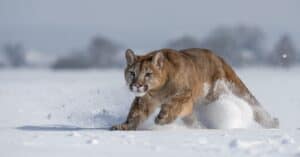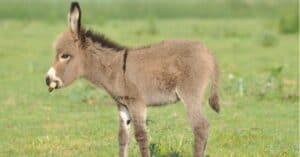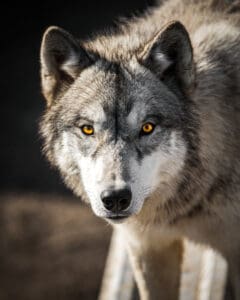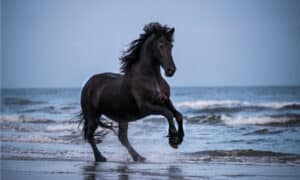Bobcat vs Coyote: Who Would Win in a Fight?
@media (min-width: 481px) {
.mobile-top-content {
display: none;
}
}
#mobileTopContentCTACarouselControls { overflow: hidden; text-overflow: ellipsis; white-space: nowrap; }
.mobile-top-content .more { color: #fff; }
.mobile-top-content a { color: #fff; text-decoration: underline; }
.mobile-top-content a:hover { color: #fff; text-decoration: underline; }
@media (max-width: 480px) {
.mobile-top-content {
background-color: #06a10b;
color: #fff;
text-align: center;
/*height: 60px;
padding-top:5px;*/
font-size:80%;
/* display: block; */
margin: 0px -30px;
}
}
Bobcats are aggressive felines that live in North America and Central America. They’re easy to hear due to their ferocious-sounding yowls, but they are otherwise quiet animals. Another animal that lives in the same semi-arid areas of the Americas as bobcats is the coyote. This cousin of the domestic canine is about the size of an average dog, and they’re a common sight in the southwest part of the U.S. When a bobcat encounters a coyote, who wins? We’ll show you how a bobcat vs coyote fight would play out!
Comparing a Bobcat and a Coyote

A-Z-Animals.com
| Bobcat | Coyote | |
|---|---|---|
| Size | Weight: 9lbs – 33lbs Length: 2ft – 3.5ft Height: 12 inches – 24 inches at the shoulder |
Weight: 15lbs – 45lbs Length: 30in – 35in Height: 24in – 26 inches at the shoulder |
| Speed and Movement Type | 35 mph | 35-40 mph |
| Bite Power and Teeth | 548 N (Estimated) – Sharp teeth that tear flesh |
681 N bite power – 42 teeth – 1.5-inch-long canines – Teeth used to grip and tear enemies. |
| Senses | – Very good vision, especially at night. – Excellent sense of hearing. – Good sense of smell |
– Great vision, including low-light and peripheral vision. – Sense of smell is similar to dogs – Good sense of hearing that allows them to hear up to a quarter of a mile |
| Defenses | – Amazing run speed – Powerful, scary yowls |
– Speed – Senses help it avoid trouble |
| Offensive Capabilities | – Strong bite, especially considering the bobcat’s size – Sharp, retractable claws |
– Strong bite that helps them latch onto enemies and bring them to the ground. – May use sharp claws as a secondary form of offense |
| Predatory Behavior | – Ambush stalker – Soft feet allows for a bobcat to walk and run very quietly – Uses a fatal bite to kill prey many times their size |
– Ambush predator when hunting alone – Hunt in packs for large prey using persistence predation. |
The Key Factors in a Fight Between a Bobcat and a Coyote
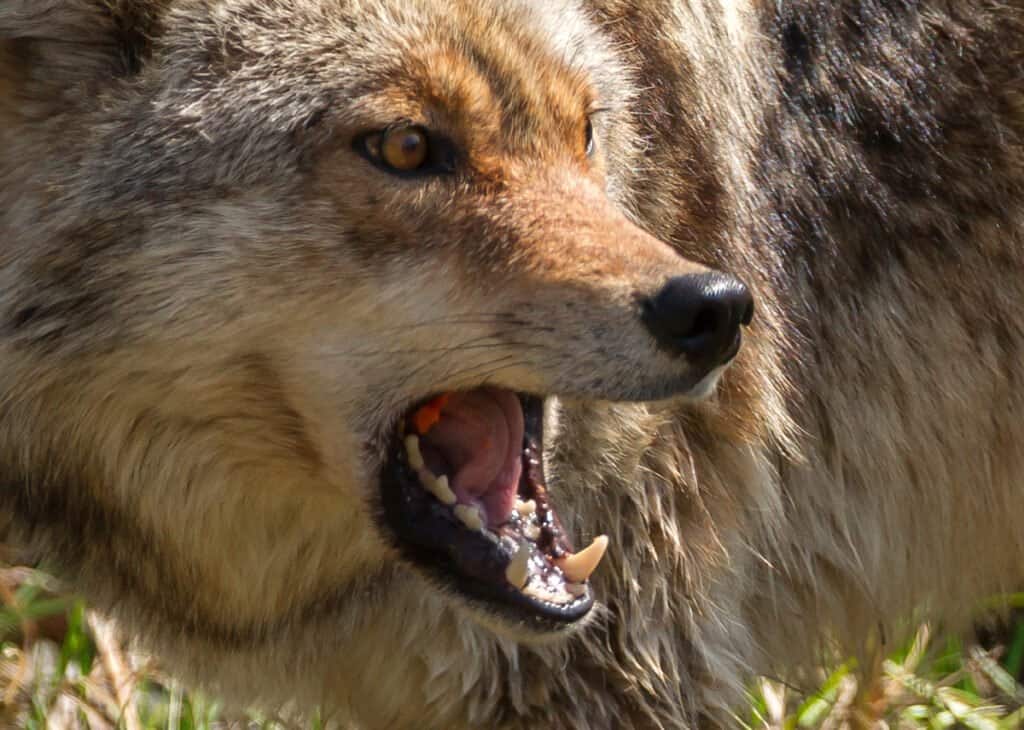
Derek R. Audette/Shutterstock.com
Bobcats and coyotes are somewhat similar in size, so how can we say which one would win a fight between the two? We’re going to compare the two creatures’ bodies and combat prowess, assigning advantages to each creature. Using that information and a little imagination, we are going to determine which of the mammals has the best chance of winning a battle.
Physical Features of a Bobcat and a Coyote

Laurie E Wilson/Shutterstock.com
Bobcats and coyotes are some of the only felines and canines that are similarly sized. We’re going to examine their size, speed, defenses, and offensive powers to see which animal is bigger, faster, and stronger. Using this data, we can surmise the animals that would have the ever-important physical advantage in a fight.
Bobcat vs Coyote: Size
Bobcats are not very large creatures. They’re a little over 30lbs at their maximum weight, and they are about 3.5ft long and 2 feet high. Coyotes are larger on average, weighing up to 45lbs and standing about 2.5 feet high.
Coyotes are just a little larger than bobcats on average, so they get the advantage here.
Bobcat vs Coyote: Speed and Movement
The bobcat is a very swift animal that can reach speeds of up to 35 mph when it’s sprinting. That speed is very similar to a coyote that can reach speeds of 35 to 40 mph.
Although the difference is small, the coyote has a speed advantage.
Bobcat vs Coyote: Bite Power and Teeth
Both the bobcat and the coyote are known for using their bites and teeth to kill their enemies. Bobcats have a somewhat weak bite that maxes out at 548 N, and they have teeth that can tear flesh. Coyotes can bite with a power of 648 N, slightly stronger than the bobcat. Also, coyotes have bigger teeth that are capable of holding onto enemies and tearing away flesh.
Coyotes have a slight advantage in terms of bite power and the length of their teeth.
Bobcat vs Coyote: Senses
Since both the bobcat and the coyote are predators, they have senses that help them find prey. Bobcats have great vision during the day and night. They also have an excellent sense of hearing and a good sense of smell.
Coyotes also have great vision in low-light settings, and their sense of smell is great, like a dog’s. Their sense of hearing is very good and allows them to hear creatures from about a quarter-mile away.
Based on their senses, we are going to call this section a tie.
Bobcat vs Coyote: Physical Defenses
Both animals rely on their speed to get away from foes. Bobcats also have a very loud, very scary threat display that includes an ear-piercing yowling noise. Coyotes have the benefit of speed and their senses to avoid trouble. They also tend to travel in packs, too.
Combat Skills of a Bobcat and a Coyote

iStock.com/GatorDawg
The bobcat is an animal that stalks its prey by sneaking up on them with its soft footfalls and pouncing at the opportune moment. They tend to quickly kill their prey with a lethal bite. Coyotes are similar in both respects, but they’re not a silent stalker like a bobcat. Also, they will frequently attack creatures in packs.
Coyotes do have one commonality though: they like to attack their enemy’s weak areas like the throat, putting a quick end to their foes. Both creatures use their claws as secondary methods of attack, inflicting moderate cuts to their opponents.
Due to the overwhelming similarities of these animals in their hunting strategies, combat skills are a tie.
What Are Key Differences Between a Bobcat and a Coyote?

Rejean Bedard/Shutterstock.com
Coyotes are larger than bobcats, and they are heavier than bobcats, too. Although they are both mammals, coyotes are more closely related to dogs, and bobcats are related to domesticated cats. Coyotes have longer teeth and bite harder than a bobcat, and their teeth are used to powerfully grip their prey.
Coyotes often hunt in packs, but bobcats are more solitary animals. Considering all these differences, the two animals still have some remarkable similarities in terms of size and strength.
Who Would Win in a Fight Between a Bobcat and a Coyote?
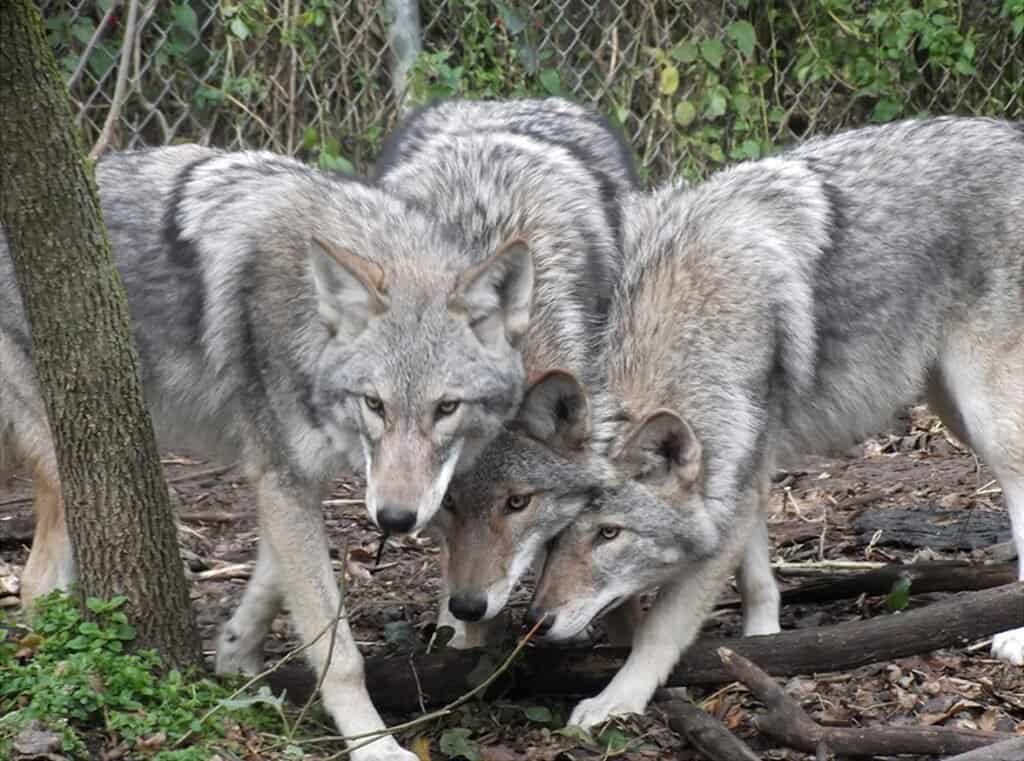
L. David Mech, Bruce W. Christensen, Cheryl S. Asa , Margaret Callahan, Julie K. Young / Creative Commons – License
A coyote would win a fight against a bobcat. Coyotes tend to be larger and stronger than bobcats. In a battle that would break down into a flurry of close-quarter attacks, it’s clear that a coyote would use its long teeth and more powerful bite to its advantage and get better outcomes.
That’s not to say a bobcat can’t win. A bobcat’s teeth and claws are capable of inflicting damage on a coyote. However, if the two were to clash in an open area with no stealth tactics, the coyote’s larger body, higher weight, and bigger teeth would overwhelm the smaller creature in most cases.
More from A-Z Animals
.more-snake-card-image { max-height:140px !important; }
@media (min-width: 481px) {
.mobile-top-content {
display: none;
}
}
#mobileTopContentCTACarouselControls { overflow: hidden; text-overflow: ellipsis; white-space: nowrap; }
.mobile-top-content .more { color: #fff; }
.mobile-top-content a { color: #fff; text-decoration: underline; }
.mobile-top-content a:hover { color: #fff; text-decoration: underline; }
@media (max-width: 480px) {
.mobile-top-content {
background-color: #06a10b;
color: #fff;
text-align: center;
/*height: 60px;
padding-top:5px;*/
font-size:80%;
/* display: block; */
margin: 0px -30px;
}
}
Bobcats are aggressive felines that live in North America and Central America. They’re easy to hear due to their ferocious-sounding yowls, but they are otherwise quiet animals. Another animal that lives in the same semi-arid areas of the Americas as bobcats is the coyote. This cousin of the domestic canine is about the size of an average dog, and they’re a common sight in the southwest part of the U.S. When a bobcat encounters a coyote, who wins? We’ll show you how a bobcat vs coyote fight would play out!
Comparing a Bobcat and a Coyote

A-Z-Animals.com
| Bobcat | Coyote | |
|---|---|---|
| Size | Weight: 9lbs – 33lbs Length: 2ft – 3.5ft Height: 12 inches – 24 inches at the shoulder |
Weight: 15lbs – 45lbs Length: 30in – 35in Height: 24in – 26 inches at the shoulder |
| Speed and Movement Type | 35 mph | 35-40 mph |
| Bite Power and Teeth | 548 N (Estimated) – Sharp teeth that tear flesh |
681 N bite power – 42 teeth – 1.5-inch-long canines – Teeth used to grip and tear enemies. |
| Senses | – Very good vision, especially at night. – Excellent sense of hearing. – Good sense of smell |
– Great vision, including low-light and peripheral vision. – Sense of smell is similar to dogs – Good sense of hearing that allows them to hear up to a quarter of a mile |
| Defenses | – Amazing run speed – Powerful, scary yowls |
– Speed – Senses help it avoid trouble |
| Offensive Capabilities | – Strong bite, especially considering the bobcat’s size – Sharp, retractable claws |
– Strong bite that helps them latch onto enemies and bring them to the ground. – May use sharp claws as a secondary form of offense |
| Predatory Behavior | – Ambush stalker – Soft feet allows for a bobcat to walk and run very quietly – Uses a fatal bite to kill prey many times their size |
– Ambush predator when hunting alone – Hunt in packs for large prey using persistence predation. |
The Key Factors in a Fight Between a Bobcat and a Coyote

Derek R. Audette/Shutterstock.com
Bobcats and coyotes are somewhat similar in size, so how can we say which one would win a fight between the two? We’re going to compare the two creatures’ bodies and combat prowess, assigning advantages to each creature. Using that information and a little imagination, we are going to determine which of the mammals has the best chance of winning a battle.
Physical Features of a Bobcat and a Coyote

Laurie E Wilson/Shutterstock.com
Bobcats and coyotes are some of the only felines and canines that are similarly sized. We’re going to examine their size, speed, defenses, and offensive powers to see which animal is bigger, faster, and stronger. Using this data, we can surmise the animals that would have the ever-important physical advantage in a fight.
Bobcat vs Coyote: Size
Bobcats are not very large creatures. They’re a little over 30lbs at their maximum weight, and they are about 3.5ft long and 2 feet high. Coyotes are larger on average, weighing up to 45lbs and standing about 2.5 feet high.
Coyotes are just a little larger than bobcats on average, so they get the advantage here.
Bobcat vs Coyote: Speed and Movement
The bobcat is a very swift animal that can reach speeds of up to 35 mph when it’s sprinting. That speed is very similar to a coyote that can reach speeds of 35 to 40 mph.
Although the difference is small, the coyote has a speed advantage.
Bobcat vs Coyote: Bite Power and Teeth
Both the bobcat and the coyote are known for using their bites and teeth to kill their enemies. Bobcats have a somewhat weak bite that maxes out at 548 N, and they have teeth that can tear flesh. Coyotes can bite with a power of 648 N, slightly stronger than the bobcat. Also, coyotes have bigger teeth that are capable of holding onto enemies and tearing away flesh.
Coyotes have a slight advantage in terms of bite power and the length of their teeth.
Bobcat vs Coyote: Senses
Since both the bobcat and the coyote are predators, they have senses that help them find prey. Bobcats have great vision during the day and night. They also have an excellent sense of hearing and a good sense of smell.
Coyotes also have great vision in low-light settings, and their sense of smell is great, like a dog’s. Their sense of hearing is very good and allows them to hear creatures from about a quarter-mile away.
Based on their senses, we are going to call this section a tie.
Bobcat vs Coyote: Physical Defenses
Both animals rely on their speed to get away from foes. Bobcats also have a very loud, very scary threat display that includes an ear-piercing yowling noise. Coyotes have the benefit of speed and their senses to avoid trouble. They also tend to travel in packs, too.
Combat Skills of a Bobcat and a Coyote

iStock.com/GatorDawg
The bobcat is an animal that stalks its prey by sneaking up on them with its soft footfalls and pouncing at the opportune moment. They tend to quickly kill their prey with a lethal bite. Coyotes are similar in both respects, but they’re not a silent stalker like a bobcat. Also, they will frequently attack creatures in packs.
Coyotes do have one commonality though: they like to attack their enemy’s weak areas like the throat, putting a quick end to their foes. Both creatures use their claws as secondary methods of attack, inflicting moderate cuts to their opponents.
Due to the overwhelming similarities of these animals in their hunting strategies, combat skills are a tie.
What Are Key Differences Between a Bobcat and a Coyote?

Rejean Bedard/Shutterstock.com
Coyotes are larger than bobcats, and they are heavier than bobcats, too. Although they are both mammals, coyotes are more closely related to dogs, and bobcats are related to domesticated cats. Coyotes have longer teeth and bite harder than a bobcat, and their teeth are used to powerfully grip their prey.
Coyotes often hunt in packs, but bobcats are more solitary animals. Considering all these differences, the two animals still have some remarkable similarities in terms of size and strength.
Who Would Win in a Fight Between a Bobcat and a Coyote?

L. David Mech, Bruce W. Christensen, Cheryl S. Asa , Margaret Callahan, Julie K. Young / Creative Commons – License
A coyote would win a fight against a bobcat. Coyotes tend to be larger and stronger than bobcats. In a battle that would break down into a flurry of close-quarter attacks, it’s clear that a coyote would use its long teeth and more powerful bite to its advantage and get better outcomes.
That’s not to say a bobcat can’t win. A bobcat’s teeth and claws are capable of inflicting damage on a coyote. However, if the two were to clash in an open area with no stealth tactics, the coyote’s larger body, higher weight, and bigger teeth would overwhelm the smaller creature in most cases.





